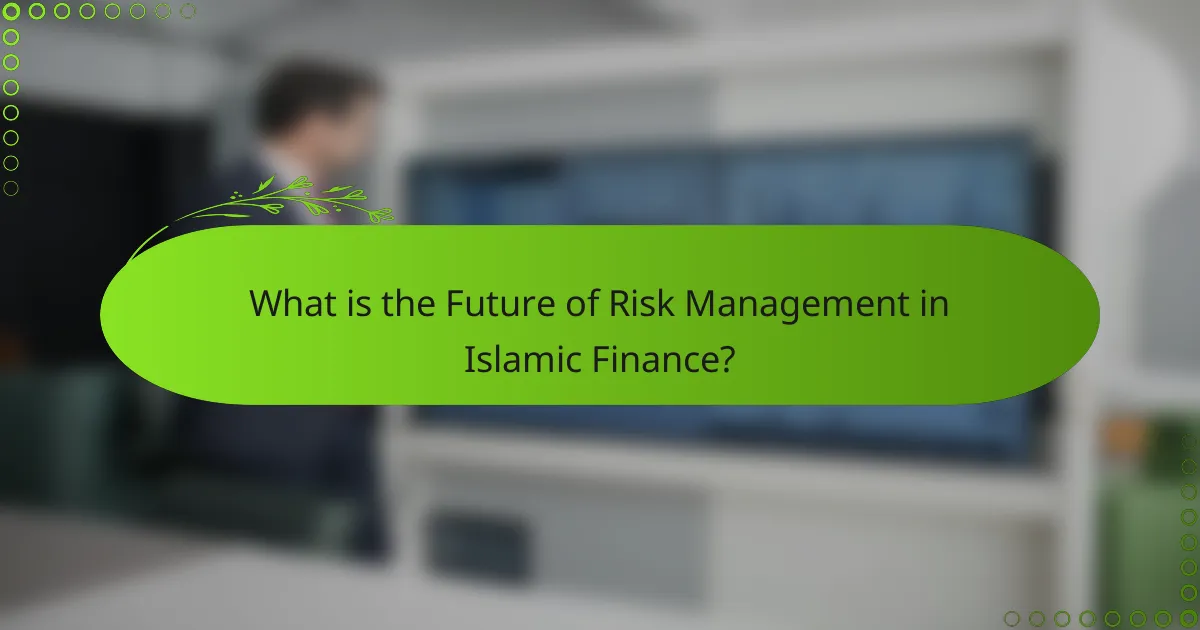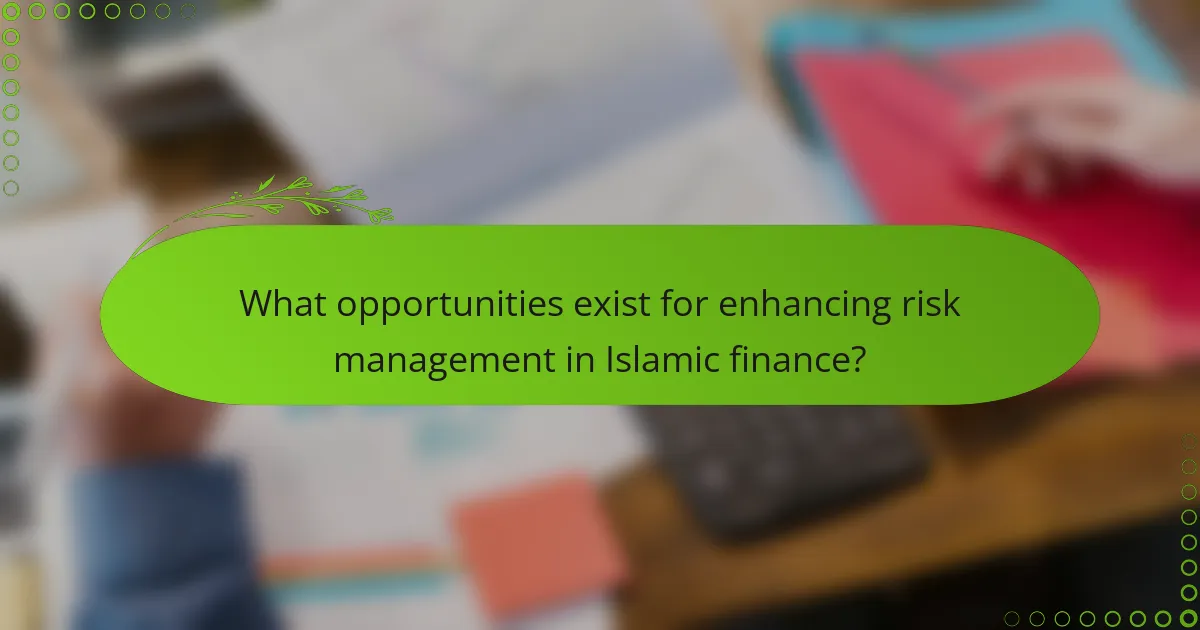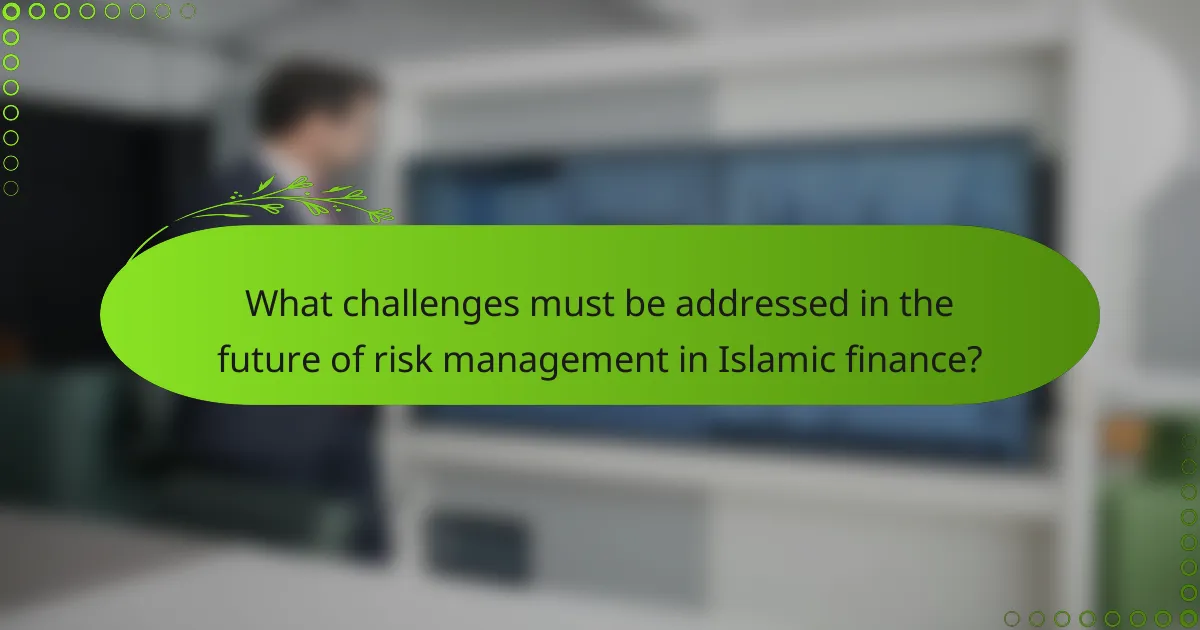
What is the Future of Risk Management in Islamic Finance?
The future of risk management in Islamic finance will focus on integrating advanced technologies and innovative practices. This evolution is driven by the need for compliance with Shariah law while managing financial risks effectively. Emerging technologies such as blockchain and artificial intelligence are expected to play a significant role. These tools can enhance transparency and improve risk assessment processes. Additionally, there is a growing emphasis on developing risk management frameworks that align with Islamic principles. This alignment ensures that financial products remain ethical and socially responsible. The global Islamic finance market is projected to grow significantly, increasing the demand for sophisticated risk management solutions. According to a report by the Islamic Financial Services Board, the Islamic finance industry is expected to reach $3.69 trillion by 2024. This growth presents ample opportunities for innovation in risk management practices.
How is risk management defined within the context of Islamic finance?
Risk management in Islamic finance is defined as the process of identifying, assessing, and mitigating risks while adhering to Shariah principles. This approach emphasizes ethical considerations and prohibits practices like interest (riba) and excessive uncertainty (gharar). Islamic finance focuses on risk-sharing rather than risk transfer. It encourages investment in tangible assets and productive activities. By aligning financial transactions with Islamic values, risk management fosters social justice and economic development. This framework ensures that risks are managed in a way that is compliant with religious guidelines. Therefore, risk management in Islamic finance integrates financial prudence with ethical obligations.
What are the unique principles of Islamic finance that influence risk management?
The unique principles of Islamic finance that influence risk management include the prohibition of riba (interest), gharar (excessive uncertainty), and haram (forbidden) activities. Riba ensures that financial transactions are based on tangible assets, promoting ethical investments. Gharar emphasizes transparency in contracts to minimize ambiguity, enhancing trust among parties. The avoidance of haram activities aligns financial practices with Islamic law, ensuring ethical compliance. These principles foster a risk-sharing environment rather than risk transfer, promoting stability and fairness in financial dealings. The adherence to these principles is evidenced by the growth of Sharia-compliant financial products, which have increased by 10% annually, reflecting their effectiveness in managing risk within the Islamic finance sector.
How does Sharia law impact risk management practices?
Sharia law significantly impacts risk management practices in Islamic finance. It prohibits activities involving excessive uncertainty (gharar) and interest (riba). This leads to a focus on ethical investments and risk-sharing mechanisms. Islamic finance emphasizes asset-backed financing, ensuring that transactions are linked to tangible assets. Consequently, risk management practices must align with Sharia principles to avoid non-compliance. Institutions often employ Sharia boards to oversee and guide risk management strategies. This ensures adherence to Islamic law while managing financial risks effectively. Overall, Sharia law shapes a distinctive framework for assessing and mitigating risks in Islamic finance.
What are the key innovations shaping risk management in Islamic finance?
Key innovations shaping risk management in Islamic finance include enhanced technology integration, improved regulatory frameworks, and the development of Sharia-compliant risk assessment models. Technology integration, such as blockchain and AI, increases transparency and efficiency in transactions. Improved regulatory frameworks ensure compliance with Sharia principles while managing risks effectively. Sharia-compliant risk assessment models provide tailored solutions for identifying and mitigating risks unique to Islamic finance. These innovations collectively enhance the resilience and adaptability of Islamic financial institutions in a dynamic market environment.
How are technology advancements influencing risk assessment in Islamic finance?
Technology advancements are significantly influencing risk assessment in Islamic finance. These advancements include big data analytics, artificial intelligence, and blockchain technology. Big data analytics allows for improved data collection and analysis, enabling more accurate risk predictions. Artificial intelligence enhances decision-making processes through predictive modeling and automated assessments. Blockchain technology increases transparency and traceability, reducing fraud risks. According to a 2020 report by the Islamic Financial Services Board, these technologies can enhance compliance with Shariah principles while improving risk management frameworks. The integration of these technologies leads to more efficient and effective risk assessment practices in the Islamic finance sector.
What role do fintech solutions play in modernizing risk management?
Fintech solutions play a crucial role in modernizing risk management by enhancing data analytics and improving decision-making processes. These technologies enable real-time monitoring of financial transactions, which helps in identifying potential risks promptly. For instance, machine learning algorithms analyze vast datasets to detect anomalies indicative of fraud. Additionally, fintech platforms facilitate better risk assessment through advanced modeling techniques. They provide predictive analytics that help organizations anticipate market fluctuations and adjust their strategies accordingly. The integration of blockchain technology in fintech enhances transparency and traceability in transactions, further mitigating risks. According to a report by McKinsey, firms adopting fintech solutions in risk management can reduce operational costs by up to 30%. This demonstrates the significant impact fintech has on improving efficiency and accuracy in risk management practices.
What trends are emerging in risk management for Islamic finance?
Emerging trends in risk management for Islamic finance include enhanced regulatory frameworks, increased use of technology, and a focus on sustainable finance. Regulatory frameworks are evolving to ensure compliance with Sharia principles while managing risks effectively. Technology adoption, such as blockchain and artificial intelligence, is improving transparency and efficiency in risk assessment. Furthermore, there is a growing emphasis on sustainable finance, aligning investment strategies with ethical and environmental considerations. These trends are reshaping the landscape of risk management in Islamic finance, promoting resilience and innovation in the sector.
How are regulatory changes affecting risk management strategies?
Regulatory changes are significantly impacting risk management strategies in Islamic finance. These changes often introduce new compliance requirements. Organizations must adapt their risk assessment frameworks to align with updated regulations. Enhanced transparency and reporting standards are often mandated. This necessitates the development of more robust data management systems. Financial institutions may need to revise their risk appetite statements accordingly. The Basel III framework is an example of such regulatory influence globally. It emphasizes liquidity and capital adequacy, which directly affects risk management practices.
What are the implications of global economic shifts on Islamic finance risk management?
Global economic shifts significantly impact Islamic finance risk management. Changes in global markets influence liquidity, investment flows, and asset valuations. Economic downturns can lead to increased default risks for Islamic financial institutions. Additionally, fluctuating commodity prices affect the profitability of Sharia-compliant investments. Regulatory changes in major economies can alter the operational landscape for Islamic finance. Furthermore, geopolitical tensions may heighten risk exposure in certain regions. Overall, these shifts necessitate adaptive strategies in risk assessment and management within Islamic finance frameworks.

What opportunities exist for enhancing risk management in Islamic finance?
Opportunities for enhancing risk management in Islamic finance include the integration of technology, improved regulatory frameworks, and enhanced risk assessment methodologies. Technology such as blockchain can increase transparency and reduce fraud. Regulatory frameworks can be tailored to address unique Islamic finance principles. Enhanced risk assessment methodologies can incorporate Sharia-compliant financial instruments. Collaboration with global risk management bodies can also provide best practices. Data analytics can enable better decision-making and predictive modeling. Training and education can improve the understanding of risk among stakeholders. These opportunities align with the growing demand for robust risk management in the evolving Islamic finance landscape.
How can Islamic financial institutions leverage new technologies for risk management?
Islamic financial institutions can leverage new technologies for risk management by adopting advanced data analytics and artificial intelligence. These technologies enhance predictive capabilities, allowing institutions to identify potential risks more effectively. For example, big data analytics can analyze vast amounts of financial data to detect patterns and trends that indicate risk exposure. Machine learning algorithms can continuously improve risk assessment models based on historical data. Additionally, blockchain technology can provide transparent transaction records, reducing fraud risk. According to a report by Deloitte, 63% of financial institutions believe that AI will enhance their risk management processes. This demonstrates the growing recognition of technology’s role in improving risk management in Islamic finance.
What specific technologies are most promising for improving risk management?
Artificial intelligence (AI) and machine learning (ML) are promising technologies for improving risk management. AI can analyze vast datasets to identify patterns and predict potential risks. Machine learning algorithms can adapt and learn from new data, enhancing their predictive capabilities. Blockchain technology offers transparency and traceability, which are crucial for risk assessment. Additionally, big data analytics enables organizations to process and analyze large volumes of data, leading to better-informed decisions. Cybersecurity technologies protect sensitive information, reducing the risk of data breaches. These technologies collectively enhance risk identification, assessment, and mitigation strategies in various sectors, including finance.
How can data analytics enhance decision-making in risk management?
Data analytics enhances decision-making in risk management by providing actionable insights from complex data sets. It enables organizations to identify potential risks through predictive modeling and trend analysis. For instance, companies can analyze historical data to forecast future risks. This allows for more proactive risk mitigation strategies. Additionally, data analytics improves accuracy in risk assessment by quantifying potential impacts. According to a report by Deloitte, organizations that utilize data analytics achieve a 20% improvement in risk identification. Enhanced decision-making leads to better resource allocation and operational efficiency. Ultimately, data analytics supports informed decisions that align with organizational goals.
What collaborative efforts can strengthen risk management practices?
Collaborative efforts that can strengthen risk management practices include cross-sector partnerships, knowledge sharing, and joint training programs. Cross-sector partnerships allow financial institutions to leverage diverse expertise and resources. Knowledge sharing among organizations promotes best practices and innovative solutions. Joint training programs enhance the skills of risk management professionals. According to a study by the World Bank, collaboration can reduce operational risks by up to 30%. Such practices create a more resilient financial ecosystem.
How can partnerships between Islamic banks and tech firms benefit risk management?
Partnerships between Islamic banks and tech firms can enhance risk management by leveraging advanced technologies. These collaborations can improve data analytics, allowing banks to assess risks more accurately. Enhanced data analytics leads to better credit scoring and risk assessment models. Furthermore, technology can streamline compliance with Shariah regulations, reducing operational risks. Automated systems can monitor transactions in real-time to detect anomalies. This proactive approach minimizes fraud and enhances transparency. According to a report by McKinsey, digital tools can reduce risk management costs by up to 30%. Overall, such partnerships create a more resilient financial ecosystem.
What role do educational initiatives play in improving risk management understanding?
Educational initiatives significantly enhance understanding of risk management. They provide essential knowledge and skills necessary for effective decision-making. Training programs and workshops are vital components of these initiatives. They cover key concepts, frameworks, and best practices in risk management. Research shows that organizations with robust training see improved risk assessment outcomes. For example, a study by the Global Association of Risk Professionals found that 70% of participants reported increased confidence in managing risks after attending training sessions. This indicates a direct correlation between education and risk management proficiency. Thus, educational initiatives are crucial for fostering a deeper understanding of risk management principles.

What challenges must be addressed in the future of risk management in Islamic finance?
The future of risk management in Islamic finance must address several challenges. One significant challenge is the lack of standardized risk assessment frameworks. Different Islamic financial institutions may adopt varying approaches, leading to inconsistencies. Another challenge is the integration of technology in risk management practices. Many institutions struggle to implement advanced analytics and digital solutions effectively. Regulatory compliance also poses difficulties. Islamic finance operates under specific Shariah principles, which can complicate adherence to global financial regulations. Additionally, there is a need for enhanced understanding of market risks unique to Islamic finance. This includes the impact of non-interest-based financial products on liquidity and credit risk. Finally, building a skilled workforce proficient in both Islamic finance and risk management is essential. The current talent pool may lack the necessary expertise to navigate these complexities.
What are the main obstacles to implementing innovative risk management solutions?
The main obstacles to implementing innovative risk management solutions include regulatory constraints, lack of skilled personnel, and resistance to change. Regulatory constraints can hinder the adoption of new technologies and practices in risk management. For instance, compliance requirements may limit the flexibility needed for innovation. Lack of skilled personnel affects the ability to effectively implement and utilize innovative solutions. According to a report by the World Economic Forum, many organizations struggle to find qualified experts in risk management technologies. Resistance to change often arises from established organizational cultures. Employees may be hesitant to adopt new methods, fearing disruption to existing processes. These factors collectively create significant barriers to innovation in risk management.
How can cultural perceptions of risk affect management practices?
Cultural perceptions of risk significantly influence management practices. Different cultures have varying attitudes toward uncertainty and risk-taking. For instance, cultures that prioritize collectivism may adopt risk-averse strategies to protect group interests. In contrast, individualistic cultures might embrace risk for potential rewards.
In Islamic finance, cultural perceptions shape risk management by adhering to Sharia principles. These principles foster a risk-sharing approach rather than risk transfer. This cultural context encourages practices that promote ethical investments and social responsibility.
Research shows that cultural dimensions, such as uncertainty avoidance and power distance, impact decision-making processes in organizations. A study by Hofstede highlights how these dimensions influence risk perception and management strategies across different countries. Understanding these cultural factors is essential for effective risk management in diverse environments.
What regulatory hurdles must be navigated for effective risk management?
Regulatory hurdles for effective risk management in Islamic finance include compliance with Sharia law, regulatory frameworks, and international standards. Sharia law dictates specific financial practices, which may conflict with conventional regulatory requirements. Regulators must ensure adherence to both Sharia principles and local laws. This dual compliance can complicate risk assessment processes. Additionally, varying interpretations of Sharia by different scholars can create inconsistencies. Regulatory bodies may also lack expertise in Islamic finance, leading to challenges in oversight. Furthermore, the absence of standardized risk management guidelines specific to Islamic finance can hinder effective implementation. These factors collectively pose significant challenges in navigating regulatory landscapes for risk management.
What best practices can guide effective risk management in Islamic finance?
Effective risk management in Islamic finance involves adhering to Shariah principles and implementing robust frameworks. Best practices include conducting thorough risk assessments to identify potential financial and operational risks. Establishing a clear governance structure is essential for accountability and oversight. Regular training and awareness programs for stakeholders ensure compliance with Islamic finance principles. Utilizing risk mitigation tools, such as profit-sharing contracts, can align interests between parties. Continuous monitoring and reporting of risks help in timely decision-making. Engaging with Shariah scholars provides guidance on compliance issues. Finally, integrating technology to enhance data analysis and risk modeling is increasingly vital. These practices collectively enhance resilience and sustainability in Islamic finance.
How can institutions develop a robust risk management framework?
Institutions can develop a robust risk management framework by implementing a systematic approach. This includes identifying potential risks relevant to their operations. Institutions should assess the likelihood and impact of these risks. They need to establish clear risk tolerance levels. Developing comprehensive policies and procedures is crucial for effective risk management. Training staff on risk awareness enhances the framework’s effectiveness. Regularly reviewing and updating the risk management framework is necessary to adapt to changing circumstances. According to a study by the Islamic Financial Services Board, effective risk management practices can significantly improve institutional resilience.
What strategies can be employed to foster a risk-aware culture within organizations?
To foster a risk-aware culture within organizations, leaders should implement comprehensive training programs. These programs educate employees about risk management principles and practices. Regular workshops and seminars can reinforce the importance of risk awareness. Additionally, organizations should encourage open communication regarding risks. This includes creating channels for employees to report potential risks without fear of retribution. Establishing a risk management framework is crucial. This framework should outline roles and responsibilities related to risk. Furthermore, integrating risk management into decision-making processes enhances accountability. Organizations can also utilize technology to monitor and assess risks continuously. By doing so, they can respond proactively to emerging threats. These strategies collectively contribute to a robust risk-aware culture.
The main entity of the article is risk management within the context of Islamic finance. The article explores the future of risk management in Islamic finance, highlighting the integration of advanced technologies such as blockchain and artificial intelligence, which enhance transparency and risk assessment. It discusses unique principles of Islamic finance that shape risk management practices, including the prohibition of interest and excessive uncertainty, and outlines emerging trends such as regulatory changes and a focus on sustainable finance. Additionally, it identifies opportunities for innovation in risk management and the challenges that must be addressed, emphasizing the importance of a robust framework and a risk-aware culture within organizations.